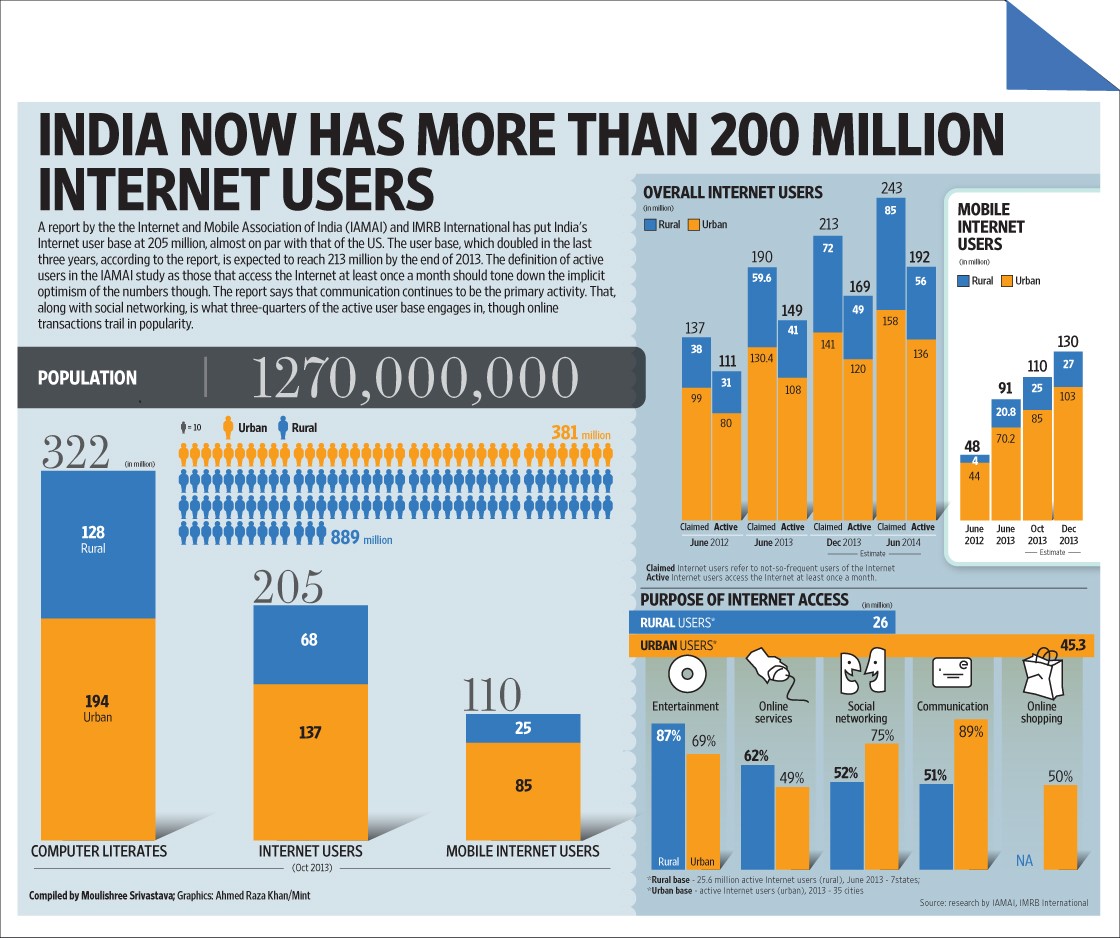
India is emerging as a formidable force in the digital economy. With an impressive volume and growth rate in key metrics such as internet connections and app downloads, it surpasses most other nations. The government and private sector are making concerted efforts to expand high-speed connectivity nationwide and equip Indian consumers and businesses with the necessary hardware and services to go online. What are the economic implications of this enhanced connectivity? And how efficiently and effectively can India leverage digital technologies to promote the well-being of its entire population?
Based on India’s outlook on, ‘reform, perform and transform”, the country has underscored the importance of innovation-driven development, facilitation of entrepreneurial ventures, enhancement of infrastructural facilities, and the digital revolution is bringing transformative changes in every sector in the emerging ‘New India’.
Digital Transformation and the Digital India Stack
India has taken a unique approach to digitizing its economy compared to other developed countries. With an open internet and no firewall separating it from the rest of the world, India has utilized the internet to develop a wide range of digital public goods and government services. As a result, India has been able to establish a more democratic and inclusive digital network and infrastructure that connects with a large number of citizens.
The cornerstone of this infrastructure is the “India Stack”, a set of open Application Programming Interfaces (API), which is unlocking economic building blocks like identity, digital payments and data, thereby developing a system to enable the exchange of goods and services and to provide a means for conducting transactions.
Another component of the Digital India Stack is the Unified Payments Interface (UPI), which has over 350 banks and 260 million unique users on its network, making it India’s largest and the world’s fifth-largest digital payment network by volume.

The creation of the Unified Payments Interface (UPI) has had a profound impact on the behavior of Indians, resulting in long-term positive changes such as:
- Formalizing India’s digital economy through cashless and paperless transactions.
- Increasing financial inclusion by bringing small businesses and unbanked individuals into the formal economy, creating financial records and credit histories, and enabling access to credit.
- Providing an alternative retail payment system and reducing reliance on existing card-based payment systems.
- Creating an infrastructure for private companies to innovate and develop new business models, such as fintech and e-commerce solutions.
Due to the creation of this stack, along with the effects of the pandemic and the expanding e-commerce market, digital payments have experienced a significant increase in India, with UPI leading the way. and confirming its bright future in the country
The economic effects of digitalization are evident throughout the Indian economy.
- Between 2014 and 2019, the proportion of India’s core digital economy in its Gross Value Added (GVA) increased from 5.4% to 8.5%, with the digitally dependent economy estimated to represent approximately 22% of the country’s Gross Domestic Product (GDP) in 2019.
- In terms of US dollars, India’s digital economy expanded at a rate of 15.6% between 2014 and 2019, which was 2.4 times quicker than the growth of the Indian economy as a whole.
- The digital output multiplier increased from 1.35 in 2014 to 1.52 in 2019, indicating the importance of investment in driving growth.
- In 2019, the digitally dependent economy employed 62.4 million workers.
MSMEs and Digitization
MSMEs have experienced significant growth due to their low-cost structures and various benefits such as exemption from the provident fund, gratuity fund, and excise duty (for industries with a turnover of fewer than 1.5 crores). These benefits have allowed MSMEs to price their products competitively and maintain profit margins while competing with larger established companies.
However, the Government of India’s recent digitalization efforts, including the introduction of the Goods and Services Tax (GST), have increased compliance costs for MSMEs by requiring them to register and file returns for GST. This has placed an additional burden on MSMEs and slowed their growth.
Digital transformation through cloud computing for the ICT domain sector, machine learning, data mining, and the Internet of Things (IoT) could significantly change the face of the MSME sector and enable them to compete with larger players in the industry.
Digitalization could benefit MSMEs in several ways:
➢ Access to knowledge and international best practices
➢ Operational excellence through real-time insights into global demand
➢ Improved financial knowledge for better decision-making, risk mitigation, and compliance
➢ Better understanding of market segmentation, targeting, and positioning
➢ More efficient provisioning of products and services
However, MSMEs face several challenges in embracing digital transformation, including the need for investment in technology, inefficient supply chain management, increasing global competition, uncertain market conditions, lack of awareness of the benefits of digitalization, and a shortage of skilled manpower to effectively implement new technologies
Impact of Digitalization on the manufacturing sector
Digitalization has had a significant impact on the development of the Indian economy, particularly in the manufacturing sector. Following digitalization, the manufacturing sector has emerged as one of the high-growth areas in India. The Government of India’s “Make in India” program was launched with the aim of making India a global manufacturing hub. The government aims to achieve a 25% share of GDP and create 100 million jobs in this sector by 2023.
Manufacturing has played a key role in driving development during industrial revolutions around the world. Globally, the manufacturing industry has increased productivity, but this has yet to happen on a large scale in India due to slow progress in automation and digitization. If this gap is addressed, the manufacturing industry has a bright future in India due to its large workforce and potential for significant growth in employment compared to other sectors. This could boost domestic revenue and have a major impact on the Indian economy.

Terms such as Industry 4.0, smart manufacturing, and the Internet of Things (IoT) represent the evolution of digital technology. Indian companies should understand the implications of adopting these technologies in their industries, including:
➢ Reducing downtime and increasing productivity
➢Tracking resources, materials, and people
➢Using data generated by IoT applications wisely to change the face of the industry through effective marketing and other means
➢Addressing the main hurdle faced by many manufacturing industries: capital expenditure (CapEx). Billions of dollars in CapEx are needed to drive growth in manufacturing GDP.
The development of the manufacturing industry will create millions of job opportunities, improve living conditions, provide direct benefits for skills training and enhancement, and more. Digitalization will significantly impact efficiency and drive significant changes.
The Indian government has been increasingly digitizing its interactions with citizens, making obtaining licenses and certificates easier, paying taxes, and improving governance outcomes. The government has also digitized the procurement of goods and services by establishing a centrally managed marketplace – the Government eMarketplace (GeM) – which has an annual gross merchandise value of US$14.2 billion.
During the pandemic, social aspects of digitalization were facilitated by India’s digital public infrastructure – COWIN36 – a technology platform created by the government to manage the rollout of the world’s largest vaccination program.
Broadband usage has been increasing rapidly, driving growth in marketplaces

Broadband usage in India has been growing at an unprecedented rate. Over the past five years, the number of mobile broadband (MBB) subscribers has grown from 345 million to 765 million. During the same period, data traffic per user increased by 31%, reaching 17GB as of December 2021. Consequently, India’s data traffic usage from 2017 to 2021 was among the highest globally, with a compound annual growth rate (CAGR) of 53%. On average, members of India’s Gen Z spend eight hours per day online. The next wave of smartphone adoption is taking place in rural India.
By 2030, India is expected to have the second-largest number of online shoppers, estimated at between 500 and 600 million.
Online marketplaces have been growing rapidly across all sectors of the economy. As a result of this behavioural change, these metrics are expected to continue to grow rapidly. The size of the e-commerce market is projected to reach US$350 billion by 2030.
To Conclude
According to projections, India could become the third-largest economy in the world by 2026, behind only the United States and China. According to Bloomberg projections, India’s Gross Domestic Product (GDP) is expected to increase from $2.7 trillion in 2019 to $5 trillion in 2025 and $8.4 trillion by 2030, necessitating an annual growth rate of 8%. While this will not be an easy feat, India has the resources and capabilities to achieve this target.
The coronavirus pandemic has prompted many foreign companies to move their operations out of China. India must seize this opportunity and take advantage of the situation. With the help of digitalization, India is already making inroads into the global economy. The ultimate goal is to increase financial literacy in India.
